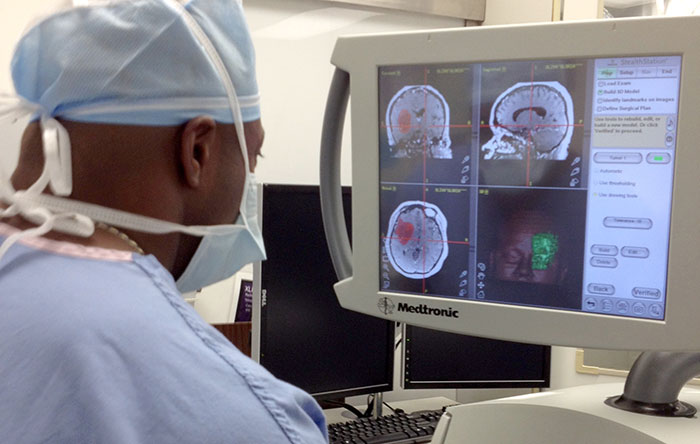Tumors of the Brain and Spine

Patients with tumors of brain and spinal cord benefit from a multidisciplinary collaboration between neurosurgeons, medical oncologists, radiation oncologists, neurologists and multiple other specialists to obtain the absolute highest level of care. At times, surgery is deferred to allow other modalities such as radiation or chemotherapy to treat the tumor. In other circumstances, surgery is the most important modality, which can be curative for certain types of tumors.
Primary brain tumors develop from cells within the brain. Part of the central nervous system (CNS), Primary brain tumors are classified by the type of cell or tissue the tumor affects, and the location and grade (1-4) of the tumor. Tumor cells may travel short distances within the brain, but generally won't travel outside of the brain itself other than in rare cases.
When cancer develops elsewhere in the body and spreads (metastasizes) to the brain, it’s called a secondary brain tumor, or metastatic brain cancer. Metastatic brain tumors are more common than primary brain tumors. Some cancers that commonly spread to the brain include lung, colon, kidney and breast cancers.
Patients with tumors of brain and spinal cord benefit from a multidisciplinary collaboration between neurosurgeons, medical oncologists, radiation oncologists, neurologists and multiple other specialists to obtain the absolute highest level of care. At times, surgery is deferred to allow other modalities such as radiation or chemotherapy to treat the tumor. In other circumstances, surgery is the most important modality, which can be curative for certain types of tumors. It is generally accepted that complete or nearly complete surgical removal of a brain tumor is beneficial for a patient. The neurosurgeon's challenge is to remove as much tumor as possible, without injuring brain tissue important to the patient's neurological function (such as the ability to speak, walk, etc.). Traditionally, neurosurgeons open the skull through a craniotomy to insure they can access the tumor and remove as much of it as possible.
Another procedure that is commonly performed, sometimes before a craniotomy, is called a stereotactic biopsy. This smaller operation allows doctors to obtain tissue in order to make an accurate diagnosis. Usually, a pre operative MRI is obtained for computerized navigation and localization, then the patient is taken to the operating area, where a small hole is drilled in the skull to allow access to the abnormal area. A small sample is obtained under neuronavigation guidance for examination under the microscope.
Investigators are developing techniques using ultrasound and performing surgery in MRI scanners to help update the navigation system data during surgery.
Intraoperative mapping of the cerebral cortex is considered by some as a critically important technique for patients with tumors affecting language function, such as large, dominant-hemisphere gliomas. This procedure involves operating on a conscious patient and mapping the anatomy of their language function during the operation. The doctor then decides which portions of the tumor are safe to resect. Recent studies have determined that cortical language mapping may be used as a safe and efficient adjunct to optimize glioma resection while preserving essential language sites.
Ventriculoperitoneal shunting may be required for some patients with brain tumors. Everyone has cerebrospinal fluid (CSF) within the brain and spine that is slowly circulating all the time. If this flow becomes blocked, the sacs that contain the fluid (the ventricles) can become enlarged, creating increased pressure within the head, resulting in a condition calledhydrocephalus.
Our neurosurgical team employs the most precise microsurgical tools in the operating room and use MRI and CT neuro-navigation, ultrasound and other imaging techniques to offer state-of-the-art microneurosurgery, which is instrumental to the patients' neurologic status and recovery.
While it is normal to feel scared, insecure, or angry about a brain tumor diagnosis, you can empower yourself to cope by taking this one step at a time.
Start gathering information. Talk to everyone who can be a resource to you. No question is too trivial.
